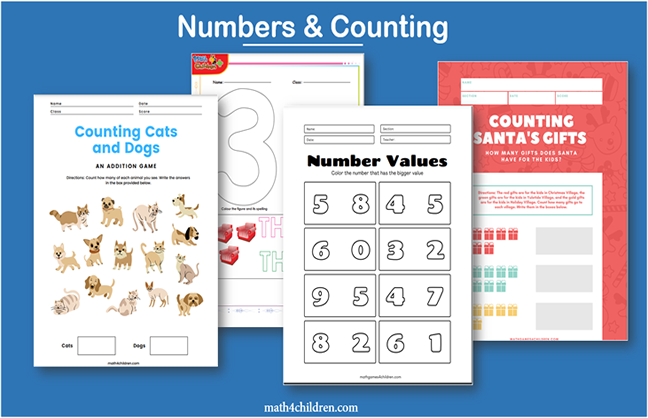![]()
Ordinal numbers worksheet for kindergarten
- Learn how to write, trace and spell the number 1
- Learn how to write, trace and spell the number 2
- Learn how to write, trace and spell the number 3
- Learn how to write, trace and spell the number 4
- Learn how to write, trace and spell the number 5
- Learn how to write, trace and spell the number 6
- Learn how to write, trace and spell the number 7
- Learn how to write, trace and spell the number 8
- Learn how to write, trace and spell the number 9
- Learn how to write, trace and spell the number 10

This page contains the ordinal numbers worksheet for kindergarten pack. When we have an infinite collection of objects in a particular order we can use ordinal numbers to express their position. For example, I could say Monday is the 1st day of the week. December is the 12th month of the year. Notice how the numbers are expressed. In these ordinal numbers activities for kindergarten, children are taught to tell the position of objects through pictures presented to them. Each worksheet contains a number of objects like shapes or letters and children are asked to tell the position of these objects.
Learning ordinal numbers also requires children to learn the right vocabulary and how to spell the numbers correctly. It is also important to note that these positions are derived from the way we will normally count and sell numbers. So for example, one is equal to the first, two is second, three is third, four is fourth, five is fifth etc. From the 4th position, the spellings are very close to the regular spelling of those numbers with the “th” addition in case or ordinal numbers.
This ordinal numbers worksheet for kindergarten collection is free and can be printed out for use at home and in the classroom. Teachers and parents will love using these worksheets.
Ordinal Numbers Worksheet for Kindergarten: A Comprehensive Guide to Understanding Ordinal Numbers
As children enter the world of mathematics, they are introduced to a wide range of concepts and terms. One such concept is ordinal numbers, which is a crucial aspect of early mathematical learning. In this article, we will dive deep into the world of ordinal numbers and explore its importance in the education of kindergarten students.
What are Ordinal Numbers?
Ordinal numbers are a type of number that are used to indicate the position or order of things in a series. They help to determine the ranking of items and provide a logical sequence to things in a specific order. For example, first, second, third, fourth, and so on are all examples of ordinal numbers.
Why are Ordinal Numbers Important for Kindergarten Students?
Ordinal numbers play a vital role in the early education of kindergarten students as they help to develop their problem-solving and critical thinking skills. By learning and practicing ordinal numbers, children can learn to understand the concept of order and sequence, which is an essential part of early mathematical learning.
Moreover, ordinal numbers also help children to understand the relationship between different objects and concepts, such as size, position, and ranking. This understanding can then be applied to a wide range of mathematical concepts and problems, making it easier for children to understand and solve mathematical problems.
How to Teach Ordinal Numbers to Kindergarten Students?
There are several ways to teach ordinal numbers to kindergarten students, including the use of worksheets, games, and interactive activities. Worksheets, in particular, are a great tool for teaching ordinal numbers as they provide a structured and organized approach to learning.
When preparing an ordinal numbers worksheet for kindergarten students, it is important to focus on simplicity and clarity. The worksheet should be easy to understand and include clear instructions on how to complete each task. Additionally, the worksheet should include a range of exercises that focus on different aspects of ordinal numbers, such as identifying and sequencing numbers, and ranking items in order.
Tips for Creating an Effective Ordinal Numbers Worksheet for Kindergarten
-
Keep it Simple: When creating an ordinal numbers worksheet for kindergarten students, it is important to keep the content simple and easy to understand. Avoid using complex language or concepts that may confuse the students.
-
Use Visual Aids: Visual aids, such as images, diagrams, and illustrations, are a great way to make the worksheet more engaging and appealing to students. They can help to clarify complex concepts and make the worksheet more enjoyable to complete.
-
Focus on Hands-On Learning: Hands-on learning is an effective way to teach ordinal numbers to kindergarten students. Encourage students to interact with the worksheet by coloring, cutting, and pasting the numbers in the correct order.
-
Make it Fun: Learning should always be fun, and the same goes for ordinal numbers. Incorporate games and activities that are both educational and enjoyable to keep students engaged and motivated.
Conclusion
Ordinal numbers are a crucial aspect of early mathematical learning and play an important role in the education of kindergarten students. By using worksheets, games, and interactive activities, teachers and parents can help children to understand and practice ordinal numbers, building the foundation for their future success in mathematics.
